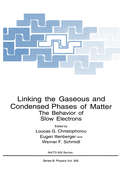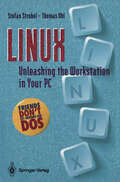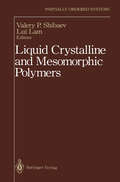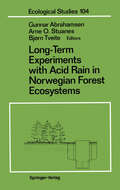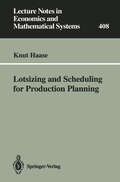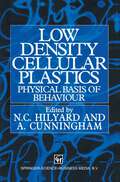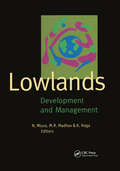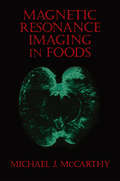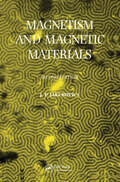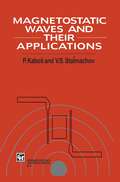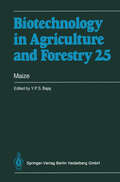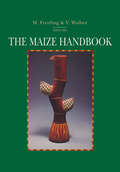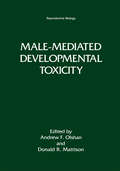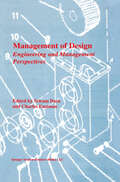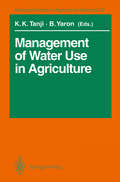- Table View
- List View
Linking the Gaseous and Condensed Phases of Matter: The Behavior of Slow Electrons (Nato Science Series B: #326)
by Loucas G. Christophorou Eugen Illenberger Werner F. SchmidtThe Advanced Study Institute (ASI) on "Linking the Gaseous and Condensed Phases of Matter: The Behavior of Slow Electrons" was held at Patras, Greece, September 5-18, 1993. The organizers of the Patras ASI felt that the study of the electronic properties of matter in various states of aggregation has advanced to a point where further progress required the interfacing of the phases of matter in order to find out and to understand how the microscopic and macroscopic properties of materials and processes change as we go from low pressure gas to the condensed phase. This approach is of foremost significance both from the point of view of basic research and of applications. Linking the electronic properties of the gaseous and condensed phases of matter is a fascinating new frontier of science embracing scientists not only from physics and chemistry but also from the life sciences and engineering. The Patras ASI brought together some of the world's foremost experts who work in the field of electronic properties of molecular gases, clusters, liquids, and solids. The thirty five lectures given at the meeting as well as the twenty nine poster papers presented and the formal and informal discussions that took place focused largely on the behavior of slow electrons in matter.
LINUX: Unleashing the Workstation in Your PC
by Stefan Strobel Thomas UhlUNIX achieved its widespread propagation, its penetration of the UNIX history university domain, and its reach into research and industry due to its early dissemination by AT&T to all interested parties at almost no cost and as source code. UNIX's present functionality emanated not just from AT&T developers but also from external developers who used the product and contributed their own further developments, which they then put at AT&T's disposal. (Consider the contributions of the University of California at Berkeley, for example.) With the rising commercialization of UNIX by AT&T (now by Novell) since 1983, such creative and cooperative further development became increasingly restricted, and UNIX source code today has become unaffordably expensive and scarcely accessible. Linux provides interested computer scientists and us"ers with a system that revives the old UNIX tradition: Linux is available for free, and everyone is heartily invited (but not obliged) to free & participatory contribute to its further development. Since Linux runs on PC systems, it has begun to penetrate the workrooms of many computer science students and computer freaks.
Linux vom PC zur Workstation: Grundlagen, Installation und praktischer Einsatz
by Stefan Strobel Thomas UhlLINUX, ein relativ neues UNIX-System für PCs hat sich in den letzten Monaten immer mehr zu einer Alternative zu kommerziellen Systemen entwickelt. Mit diesem LINUX-PowerPack erhalten Sie alles, was Sie benötigen, um Ihren PC in eine leistungsfähige UNIX-Workstation zu verwandeln.
LINUX Vom PC zur Workstation: Grundlagen, Installation und praktischer Einsatz
by Stefan Strobel Thomas UhlLiquid Crystalline and Mesomorphic Polymers (Partially Ordered Systems)
by Valery P. Shibaev Lui LamAmong the various new directions in modern polymer science, the design and investigation of liquid crystal (LC) polymers have been the ones growing most actively and fruitfully. In spite of that, the possible formation of an anisotropic LC phase was only demonstrated theoretically for the first time in the 1950s by Onsager [1] and Flory [2], and then experimentally verified in the studies with polypeptides solutions. In essence, the studies of these LC lyotropic systems did not deviate from the theme of purely academic interest. It was at the beginning of the 1970s that the experimental "explosion" occurred, when aromatic polyamides were synthesized and their ability to form LC solutions in certain very aggressive solvents was discovered. The search for practical applications of such LC systems was crowned with the successful creation of the new generation of ultrastrong high-modulus ther mostable fibers, such as the Kevlar, due to the high degree of order of the macromolecules in the anisotropic LC state. In fact, these investigations coincided with the swift emergence on the practical "scene" of thermotropic low-molar-mass liquid crystals, with the use of these materials in microelectronics and electro optics (figures and let ters indicators, displays in personal computers, and flat TV, etc.). Polymer scientists also began to develop methods of synthesizing thermotropic LC polymers by incorporating mesogenic fragments in the main (main-chain LC polymers) or side branchings of the macromolecules (side-chain or comb shaped polymers).
LLRW Disposal Facility Siting: Successes and Failures in Six Countries (Risk, Governance and Society #8)
by A. Vari Patricia Reagan-Cirincione J.L. MumpowerPlanning for the management of nuclear wastes -- whatever their level of radioactivity -- is one of the most important environmental problems for all societies that produce utility, industrial, medical, or other radioactive waste products. Attemps to site low-level radioactive waste disposal facilities in Western industrial societies, however, have repeatedly engendered conflicts between governments, encountered vehement opposition on the part of local citizen groups, and given rise to overt hostilities among involved parties. LLRW Disposal Facility Siting is the result of a study designed to learn more about the causes underlying failed and successful efforts to site LLRW disposal facilities. The study is based on case histories of LLRW disposal facility siting processes in six countries. Siting processes in five states within the United States and in five additional countries are analyzed using information obtained from public documents and supplemented by interviews with key participants. The selected states and countries are major generators of LLRW and each has made efforts to establish LLRW disposal facilities during the past decade. They vary widely in the approaches they have adopted to LLRW management, the institutional structures developed for managing the siting process, the means used to involve stakeholders and technical experts in the facility siting process and the amount and type of data used in making decisions. The analysis of these case histories provides general lessons about the advantages, disadvantages, strengths, and weaknesses of the various approaches that have been attempted or implemented. LLRW Disposal Facility Siting provides valuable data for academics and researchers working in the area of environmental management.
Logic Synthesis for Control Automata
by Samary BaranovLogic Synthesis for Control Automata provides techniques for logic design of very complex control units with hardly any constraints on their size, i.e. the number of inputs, outputs and states. These techniques cover all stages of control unit design, including: description of control unit behavior by using operator schemes of algorithms (binary decision trees) and various transformations of these descriptions -- composition, decomposition, minimization, etc.; synthesis of a control automaton (finite-state machine); synthesis of an automaton logic circuit: with matrix structure as a part of LSI or VLSI circuits; as multilevel circuit with logic gates; with standard LSI and VLSI circuits with and without memory. Each chapter contains many examples, illustrating the use of the models and methods described. Moreover, the special last chapter demonstrates in detail the whole design methodology presented in the previous chapters, through the examples of the logic design for a control unit. The models, methods and algorithms described in the book can be applied to a broad class of digital system design problems including design of complex controllers, robots, control units of computers and for designing CAD systems of VLSI circuits using FPGA, PLD and SIC technologies. Logic Synthesis for Control Automata is a valuable reference for graduate students, researchers and engineers involved in the design of very complex controllers, VLSI circuits and CAD systems. The inclusion of many examples and problems makes it most suitable for a course on the subject.
Logistikmanagement: Funktionen und Instrumente. Implementierung der Logistikkonzeption in und zwischen Unternehmen (Logistik in Industrie, Handel und Dienstleistungen)
by Hans-Christian PfohlLogistikmanagement als Realisierung in und zwischen Unternehmen verlangt ein verändertes Denken sowohl auf der operativen, als auch auf der strategischen Ebene. Das Werk stellt die verschiedenen Dimensionen des Logistikmanagements dar und analysiert die Funktion der Logistik in der Unternehmensführung.Die zunehmende Bedeutung logistischen Denkens in der Wertschöpfungskette wird nachgewiesen und die Merkmale der Logistik erfolgreicher Unternehmen beschrieben. Wegen ihrer besonderen Relevanz werden die strategische Planung in der Logistik, das Logistik-Controlling und die modellgestützte Entscheidungsfindung behandelt.
Long-Term Experiments with Acid Rain in Norwegian Forest Ecosystems (Ecological Studies #104)
by Gunnar Abrahamsen Arne O. Stuanes Bjorn TveiteAcid rain is a serious international environmental problem. Scandinavian forests have suffered especially severe damage, and have been the focus of considerable research on the causes and impacts of atmospheric pollution. This book presents the results of long-term studies on acid rain in Norwegian forests. This research examined soil chemistry and biology; the impacts of acid rain on tree growth and nutrition; and its influence on ground vegetation, fungi, and seedling germination and development. Long-Term Experiments with Acid Rain in Norwegian Forest Ecosystems is a lasting contribution to the literature on acid precipitation, and will be of interest to researchers in ecology, air pollution, forestry and environmental chemistry.
Lotsizing and Scheduling for Production Planning (Lecture Notes in Economics and Mathematical Systems #408)
by Knut HaaseBillions of dollars are tied up in the inventories of manufacturing companies which cause large (interest) costs. A small decrease of the inventory and/or production costs without reduction of the service level can increase the profit substantially. Especially in the case of scarce capacity, efficient production schedules are fundamental for short delivery time and on-time delivery which are important competitive priorities. To support decision makers by improving their manufacturing resource planning system with appropriate methods is one of the most of production planning. interesting challenges The following chapters contain new models and new solution strategies which may be helpful for decision makers and for further research in the areas of production planning and operations research. The main subject is on lotsizing and scheduling. The objectives and further characteristics of such problems can be inferred from practical need. Thus, before an outline is given, we consider the general objectives of lotsizing and scheduling and classify the most important characteristics of such problems in the following sections.
Lotto und andere Zufälle: Wie man die Gewinnquoten erhöht (Facetten)
by Karl BoschZiel des Buches ist es, Grundbegriffe aus der Wahrscheinlichkeitsrechnung und Statistik, die auch sonst im täglichen Leben oft benutzt werden, für jedermann möglichst anschaulich und verständlich darzustellen. Speziell werden folgende Bereiche behandelt: Zufallsexperimente, Häufigkeiten, Chancengleichheit, kombinatorische Methoden, geometrische Wahrscheinlichkeit, allgemeine Wahrscheinlichkeit, Zufallszahlen und Simulationen, Unabhängigkeit, Mittelwerte, Zufallsvariable und deren Erwartungswerte, Gesetz der großen Zahlen, Bevölkerungsaufbau und Lebenserwartung (Sterbetafel) und etwas über die "statistische Lüge". Die Chancen beim Lotto werden in einem sehr umfangreichen Anhang untersucht. Dort soll gezeigt werden, daß man wegen der Chancengleichheit aller fast 14 Millionen möglichen Tippreihen nicht gegen den Zufall spielen kann. Ein Gewinn hängt also vom Zufall ab. Das Verhalten der Spieler wird an einigen typischen Gewinnquoten aufgezeigt. Bei Reihen mit vielen "Geburtstagszahlen" können die Quoten extrem niedrig sein. Das gleiche gilt für Reihen mit "Mustern". Um das Verhalten der Spieler aufzuzeigen, wurden 6,8 Millionen an einem Wochenende tatsächlich abgegebene Reihen untersucht.
Low density cellular plastics: Physical basis of behaviour
by N. C. Hilyard A. CunninghamFoams are gas filled integral structures in which the gas is finely dispersed throughout acontinuouslyconnected solid phase. The bulk density is usually substantially lower than that of the solid component, and for the foams which form the focus for this book the volume fraction of the gas phase is considerably greater than 0.5 and in most instances in excess of 0.9. Many ofthe materials encountered in every day experience, such as bread, plants and trees, structural materials for buildings, comfort materials for domestic and automotive seating, shock absorbers or car bumpers and materials for noise control, have one thing in common - the cellular nature of their physical structure. Whyare thesestructuressoimportantin the naturaland man-made world? The reasons are both technical and commercial. From a technical viewpoint cellular materials offer: 1. high specific stiffness and strength - making them suitable for structural applications; 2. closeto idealenergymanagement - hencetheir useinthermalandacoustic insulation, vibration damping, acoustic absorption and shock mitigation; and 3. comfort - hence their use for domestic and automotive seating.
Lowlands
by Kenichi Koga Norihiko Miura Madhira R. MadhavThis text presents up-to-date knowledge regarding lowlands, which are lands affected by fluctuating water levels. By collating and examining relevant information concerning lowlands in one volume, this text should be of use to engineers, planners, managers, administrators and scientists.
Lowlands
by NORIHIKO MIURA; MADHIRA R.MADHAV; KENICHI KOGAThis text presents up-to-date knowledge regarding lowlands, which are lands affected by fluctuating water levels. By collating and examining relevant information concerning lowlands in one volume, this text should be of use to engineers, planners, managers, administrators and scientists.
Luftreinhaltung: Entstehung, Ausbreitung und Wirkung von Luftverunreinigungen — Meßtechnik, Emissionsminderung und Vorschriften
by Guenter BaumbachReinhaltung der Luft wird als fachübergreifendes Thema behandelt, von der Entstehung der Luftverunreinigungen, über die Ausbreitung und Umwandlung in der Atmosphäre, die Wirkungen auf Menschen, Tiere, Pflanzen und Sachgüter bis hin zu Minderungstechniken bei den verschiedenen Quellen. Die Darstellung aktueller Probleme wie Kraftfahrzeugabgase, Katalysator, Ozon, Waldschäden, polychlorierte Dioxine und -furane sowie eine gründliche Behandlung der Meßtechnik und ein Überblick über die Vorschriften runden das Werk ab.
Macromolecular Complexes in Chemistry and Biology
by Paul Dubin J. Bock Richie Davis Donald N. Schulz Curt ThiesMagnetic Resonance Imaging In Foods
by Michael J. McCarthyNuclear magnetic resonance imaging is one of several new experimental tech niques which have rec{ ,tly been applied to food systems. NMR in general and nuclear magnetic resonance imaging are powerful probes of the microscopic and macroscopic changes occurring in foods during processing, storage and utilization. The training that food scientists and food engineers have received in the past has often omitted specific courses in physical chemistry that form the theoretical and practical foundation necessary to fully utilized magnetic resonance experimental techniques. The goal of Magnetic Resonance Imaging in Foods is to introduce food scien tists and food engineers to magnetic resonance imaging and provide a basis for further study. As such the book begins with two chapters of an introductory nature. The first chapter introduces magnetic resonance phenomena, NMR in general, and MRI in detail. Particular emphasis is given to the limitations and typical ranges available for studying particular phenomena, for example, the range of diffusivities that can be studied using commercial grade NMR equipment. Chapter 2 gives a brief introduction to the classical physical model of NMR first introduced by Felix Bloch in 1946 and aspects important to the interpretation of MRI data. This chapter is provided for the researchers and students interested in more details of the basic theory. Chapter 2 can be skipped by those individuals not requiring more information on the basic theory of NMR. The next several chapters of the book are on applications of MRI to food systems.
Magnetism and Magnetic Materials
by J.P. JakubovicsMagnetic materials have many interesting and important uses. This book discusses the subject of magnetism and magnetic materials at a level suitable for undergraduates studying Materials Science, Physics or Engineering. It gives a brief introduction to the fundamental ideas in magnetism, and then explains the classification of materials
Magnetism and Magnetic Materials
by J.P. JakubovicsMagnetic materials have many interesting and important uses. This book discusses the subject of magnetism and magnetic materials at a level suitable for undergraduates studying Materials Science, Physics or Engineering. It gives a brief introduction to the fundamental ideas in magnetism, and then explains the classification of materials
Magnetostatic Waves and Their Application
by Pavel Kabos V.S. StalmachovMagnetostatic Waves and their Applications is the first book devoted to magnetostatic waves. The book gives a thorough review of the field suitable for scientists, engineers and advanced students involved in magnetism and microwave electronics new to this area. It covers the field from essential physics to applications in microwave electronics, with details of the materials and materials processing methods included.
Maize (Biotechnology in Agriculture and Forestry #25)
by Y. P. BajajForty chapters deal with various aspects of tissue culture, in vitro manipulation, and other biotechnological approaches to the improvement of maize. They are arranged in eight sections: - In Vitro Technology, Callus Cultures and Regeneration of Plants, Somatic Embryogenesis. - Wide Hybridization, Embryo, Ovule, and Inflorescence Culture, in Vitro Fertilization. - Production of Haploids and Double Haploids, Anther and Pollen Culture. - Protoplast Culture, Genetic Transformation. - Somaclonal Variation and Mutations. - Molecular Biology and Physiological Studies. - Proteins and Nutritional Improvement. Pollen Storage, Cryopreservation of Germplasm.
The Maize Handbook (Springer Lab Manuals)
by Michael Freeling Virginia WalbotThe Maize Handbook represents the collective efforts of the maize research community to enumerate the key steps of standard procedures and to disseminate these protocols for the common good. Although the material in this volume is drawn from experience with maize, many of the procedures, protocols, and descriptions are applicable to other higher plants, particularly to other grasses. The power and resolution of experiments with maize depend on the wide range of specialized genetic techniques and marked stocks; these materials are available today as the culmination of nearly 100 years of genetic research. A major goal of this volume is to introduce this genetical legacy and to highlight current stock construction programs that will soon benefit our work, e. g. high-density RFLP maps, deletion stocks, etc. Both stock construction and maintenance are relatively straightforward in maize as a result of the ease of crossing and the longevity of stored seeds. Crossing is facilitated by the separate staminate (tassel) and pistillate (ear) flowers, a feature almost unique to maize. On the other hand, many of the genetic methodologies utilized with maize, including the precision of record keeping, can be adapted to other plants. Facile communication and a spirit of co-operation have characterized the maize genetics community since its earliest days. Starting in the 1930s, institutions such as annual Maize Genetics Cooperation Newsletter, the Maize Genetics Stock Center, and the annual maize genetics meeting provide continuity to the field.
Male-Mediated Developmental Toxicity (Reproductive Biology)
by Andrew F. OlshanThe cause of many of the adverse reproductive outcomes and developmental diseases among offspring is not well understood. Most of the epidemiologic and experimental animal research has focused on the relationship between maternal exposures including medications, tobacco smoke, alcohol, infections, and occupation and the occurrence of spontaneous abortion, low birth weight, and birth defects. The potential role of paternal exposures has not been investigated as extensively despite long-standing animal research that demonstrates the induction of mutations in the male germ cell after exposure to certain agents and subsequent reproductive failure or early pregnancy loss. Given this relative lack of interest, acquisition of epidemiologic data and the development of a definitive model or mechanism for potential male-mediated effects has been hindered. However, recent laboratory and epidemiologic investigations have suggested that paternal exposures may be more important than previously suspected. This topic has been termed by some as "male-mediated developmental toxicity. " This is meant to refer to the effects of exposures and other factors relating to the male parent that result in toxicity to the conceptus and abnormal development. The developmental endpoints of interest can include fetal loss, congenital abnormalities, growth retardation, cancer, and neurobehavioral effects. These effects may operate through a variety of mechanisms including gene mutation, chromosomal aberrations, seminal fluid transfer of toxicants and epigenetic events.
Management of Design: Engineering and Management Perspectives
by Sriram Dasu Charles EastmanProduct design significantly influences product cost and quality, as well as market share and profitability of a firm. Design projects often involve many people belonging to different functional areas and in many organizations several design projects may be under way at the same time. Due to this complexity, management of design has given rise to a rich set of research problems in management and engineering. In this volume, design is considered as the planning and specification activity prior to fabrication. Design determines what products will be produced, how they will be produced, and when they will be introduced into the market. The quality of the products and the speed with which they are developed are significantly affected by the design process. The design process by which a product is developed is determined by the managerial and engineering practices, tools and techniques. This book presents engineering and management perspectives on design. Topics covered include: Decomposition of product development projects; Tools and techniques for preliminary evaluation of designs; Interface between design and manufacturing, assembly and distribution; Design information flows, and Determination of the scope, timing and duration of projects, and the allocation of resources.
Management of Water Use in Agriculture (Advanced Series in Agricultural Sciences #22)
by Kenneth K. Tanji Bruno YaronAs the world population increases, there is increasing competition for waterquantity as well as quality. Provided here is an up-to-date perspective on Available Water Resources (Part I), Water Conservation and Technology inAgricultural Systems (Part II), Problem Water Uses and Treatment (Part III),and Management and Policy Evaluation (Part IV). The book is an invaluable source of information for water resource planners, managers and policy makers, researchers and students, and irrigationists.
